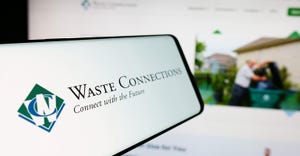Key Learnings from Covanta’s Q4 2015 Results
Morristown, N.J.-based waste and energy firm Covanta Holding Corp. reported its fourth quarter and full year earnings, which were marked by declines in revenue, EBITDA and free cash flow. But the firm did post $68 million in net income after posting a net loss of $2 million in 2014.
“While lower commodity market prices negatively impacted our results, operationally we had a strong year,” Covanta President and CEO Stephen J. Jones said in a conference call with investors. “Waste, energy and metals volumes from our energy-from-waste business came in within our forecasted ranges. We also achieved another year of record profile waste revenue, 24 percent growth rate in 2015 and are expecting to see that business grow again in 2016.”
It owns and operates 46 energy-from-waste facilities; and 11 additional energy generation facilities, including wood biomass and hydroelectric renewable energy production facilities in North America. In addition, the company owns and operates 18 transfer stations; one industrial waste treatment, storage, and disposal facility; and four ash landfills in the Northeast United States; and owns an interest in a coal-fired cogeneration facility in Taixing City, the PeopleÂ’s Republic of China.
Here are some additional highlights from the company’s results.
Covanta posted revenue of $1.65 billion in 2015, down from $1.68 billion in 2014. Its adjusted EBITDA was $428 million versus $474 million in 2014. Its free cash flow came in at $147 million, down from 240 million in 2014.
Among its highlights and accomplishments, Covanta completed 5 additional strategic acquisitions to expand Environmental Solutions business, commenced New York City MTS contract operations, established a regional metals processing facility in Fairless Hills, Pa., moved its Durham-York facility into commercial operations and is on track for a late 2017 opening at its project in Dublin, Ireland.
Same store North America energy-from-waste (Efw) revenue decreased by $47 million. That included an increase in waste and service revenue by $13 million; a decrease in $25 million in energy revenue primarily driven by lower energy pricing and a decrease in recycled metals revenue of $35 million, driven by a decline in recycled metal market pricing.
All other revenue (non-EfW operations) increased by $16 million on a consolidated basis. Waste and service revenue from non-EfW operations increased by $80 million, primarily due to the start-up of the New York City MTS contract and contribution from newly acquired environmental services businesses, while energy revenue from non-EfW operations decreased by $28 million, driven primarily by economically dispatching a biomass facility and lower market pricing. Other operating revenue decreased by $38 million, primarily due to lower construction revenue.
Excluding net write-offs, operating expense increased by $28 million to $1.5 billion.
Excluding net write-offs, operating income decreased by $65 million to $143 million in 2015 due to the revenue and expense items noted above.
Adjusted EBITDA declined by $46 million on a year-over-year basis to $428 million due to the decline in the commodities markets, start-up and construction expense associated with the Durham York facility and contract transitions, partially offset by a lower incentive accrual and the benefits from the ramp of the New York City MTS contract and Environmental Solutions acquisitions.
Free Cash Flow declined by $93 million to $147 million, primarily as a result of lower Adjusted EBITDA, higher maintenance capital expenditures, and net cash outflow for working capital.
In 2015, the Company paid its cash dividend of $1.00 per share on annualized basis and repurchased $32 million of stock in the fourth quarter.
For 2016, the company established an adjusted EBITDA guidance range of $390 million to $430 million and a free cash flow range of $140 million to $180 million.
On Feb. 11, the firm announced the execution of a long-term waste supply contract for the Dublin Waste-to-Energy Facility with Panda, one of the leading waste and recycling collection companies in Ireland. To date, 60 percent of the facility's waste processing capacity has been secured under long-term contract. When complete, the Dublin facility will process approximately 600,000 metric tonnes of waste annually and will generate clean energy to supply 80,000 homes. The facility has also been designed with technology and infrastructure to provide enough heat to meet the equivalent needs of over 50,000 homes if a district heating system is implemented in the future.
Covanta was Reiterated by Barclays to “Equal Weight” while Lowering the Price Target of the company shares to $ 16 from a previous price target of $17 . Barclays advised their investors in a research report released on Feb 16, 2016.
Stifel analyst Michael E. Hoffman wrote in a report, “CVA exited FY15 on solid footing with few surprises either pro or con. AEBITDA finished better than expected as did FCF but the outlook into FY16 frames AEBITDA as flat to down while FCF is flat to up. The latter is critical to finally silencing the naysayers who believe the dividend cannot be supported. CVA bought back ~2mm shares in 4Q15 for ~$30mm. In hindsight the BOD could (should) have raised the dividend, in our view. The buyback reduces the cash outlay for the dividend by about 1.5% for 2016. The threat of long-term low commodity prices means the operating environment for CVA remains challenged for the next couple of years until Dublin goes live. Over that period CVA should stabilize if not lower operating cost permanently from Lean/Six Sigma and begin to gradually walk EBITDA up from items like the Environmental Services Group and volume growth in metals and MWh sold.”
About the Author
You May Also Like




